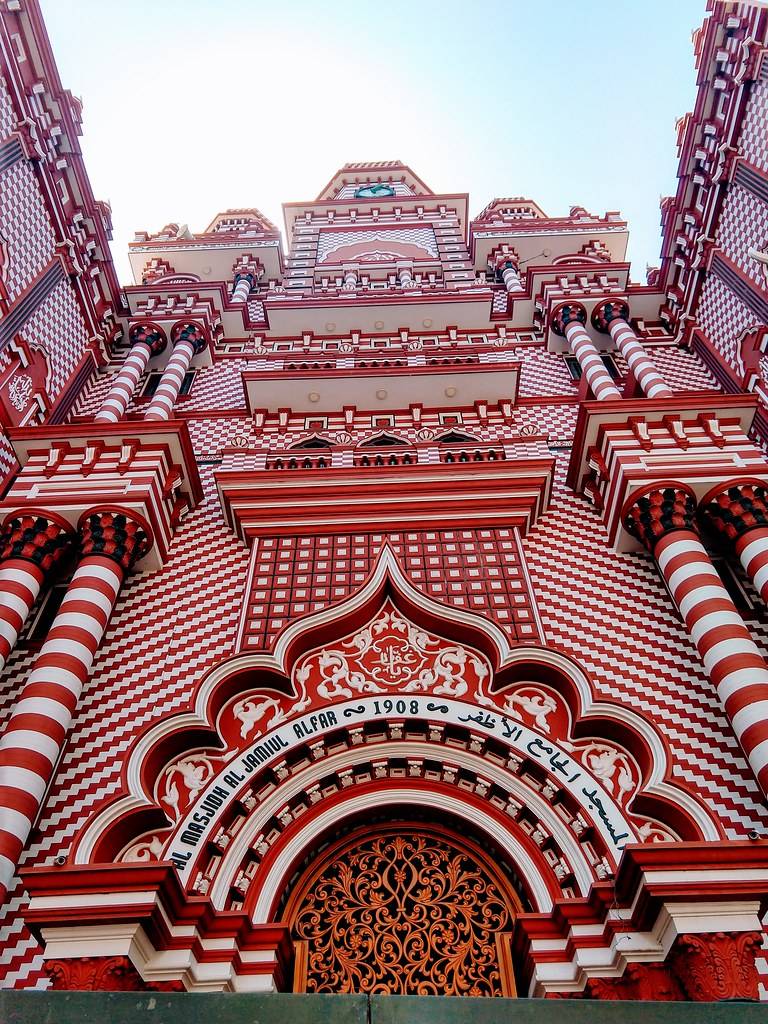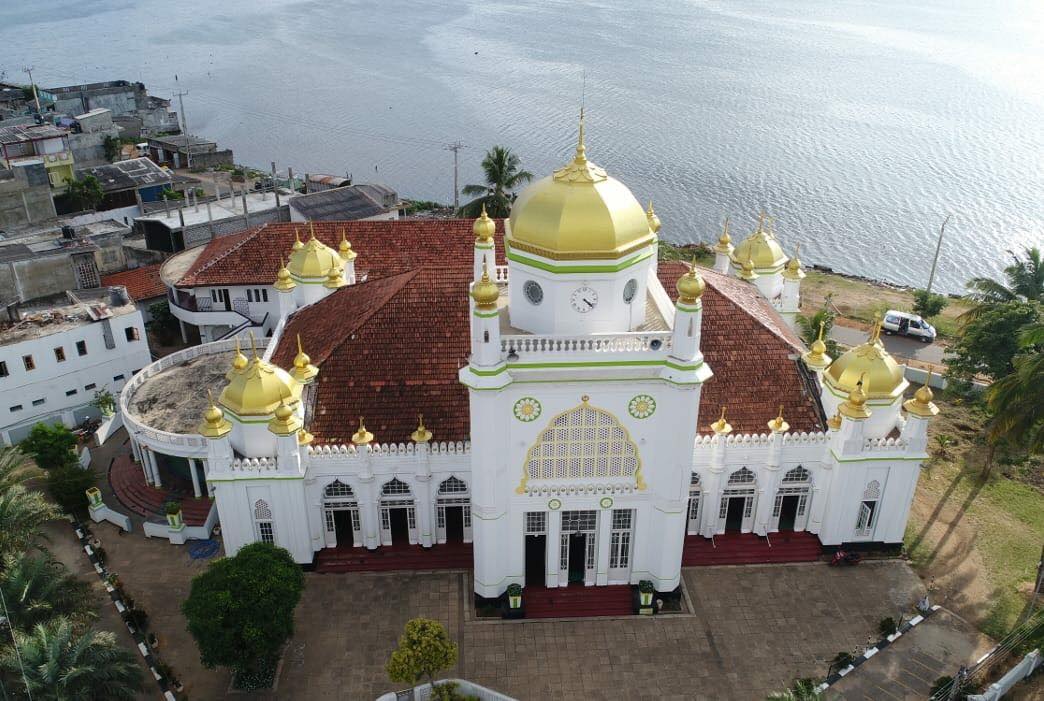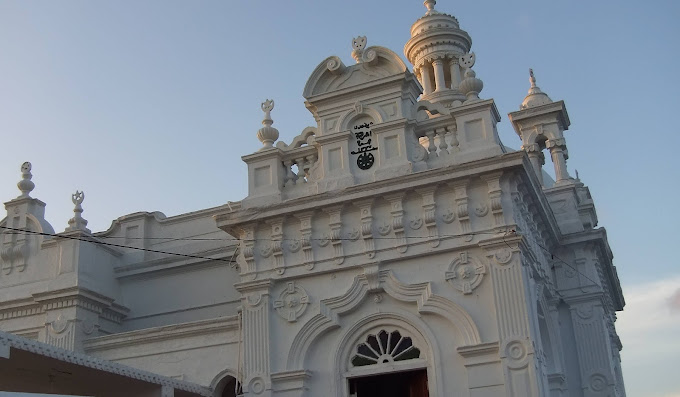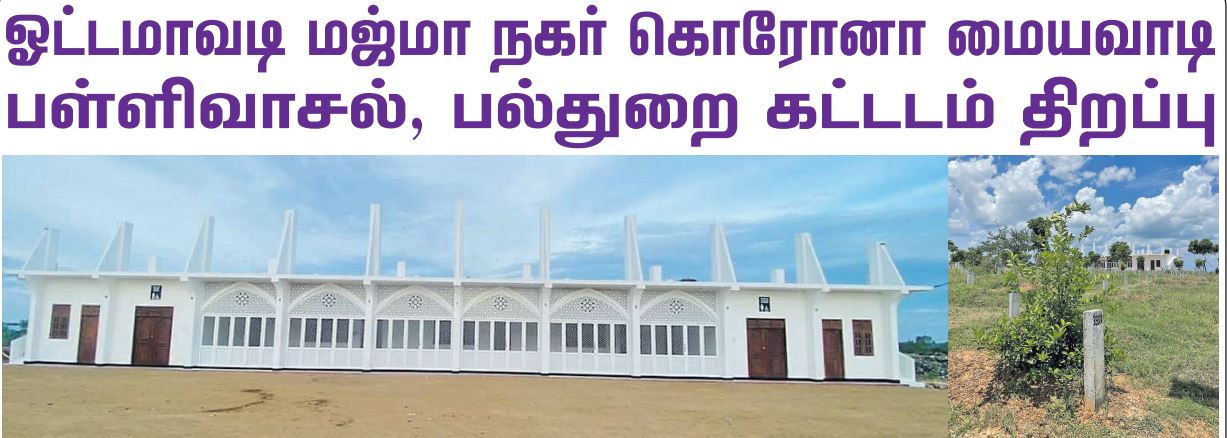 In the hustle and bustle of Pettah, Colombo’s core commercial district, is situated a most striking building, a spiritual haven called Jamiul Alfar Masjid. This mosque is remarkable because the architecture is Indo-Saracenic, incorporating pomegranate-shaped domes. But the most extraordinary feature is that each brick is painted red or white and used in contrasting designs, which gave rise to its common name, the Red Mosque.
In the hustle and bustle of Pettah, Colombo’s core commercial district, is situated a most striking building, a spiritual haven called Jamiul Alfar Masjid. This mosque is remarkable because the architecture is Indo-Saracenic, incorporating pomegranate-shaped domes. But the most extraordinary feature is that each brick is painted red or white and used in contrasting designs, which gave rise to its common name, the Red Mosque.
Words Richard Boyle Photographs Mahesh Bandara and Isuru Upeksha
During the 7th Century CE, Arab dhows with their distinctive lateen sails filled with monsoon wind began in earnest to sail south-eastwards across the Indian Ocean. Aboard were traders whose destination was the Island they called Serendib—“Island of Rubies”—in search of those precious gems, but also pungent spices, perfect pearls, and much else besides.
Used to mostly barren landscapes, these traders, many of whom came from the ancient city of Aleppo, experienced much pleasure at the sight of Nature’s verdancy and the discovery of its treasures. Thus Serendib was also known as Tenarisin, “Island of Delights” and Jazirat Kakut, “Island of Gems”.
Such was the lure of the stories conveyed not only to the traders of Aleppo but also those of Baghdad—read the astonishingly accurate portrayal of Serendib in Sinbad’s two voyages to the Island contained in the 1001 Arabian Nights—that traders began to settle down on the west coast in the 8th Century. It’s said the first settlement was at the nowadays coastal resort of Beruwela, which in Sinhala means “the place where the sail is lowered”.
These Arabs brought with them not only fabulous goods but also their beloved faith, Islam, which was then enjoying its Golden Age. Indeed some early traders made the Serendib voyage when the Prophet Mohammad was alive. There was an expansion of believers primarily due to the far-travelled traders who settled at Beruwela and elsewhere in Serendib—and all over Asia. They married local wives who had converted to Islam (today their descendants are called Sri Lankan Moors). And Beruwela is where the first mosque was built on the Island, c 920 CE, located on a rocky peninsula where the modern version now stands.
Over the next millennium much change occurred concerning the Muslim community in Sri Lanka. Until the 16th Century Arab merchants controlled much of the country’s trade with the blessing of the monarchy, which saw them as an economical and political asset. There was also racial amity between the Sinhalese and Muslims. But then the Portuguese arrived and Muslims were persecuted by the colonists, with west coast settlers fleeing to the Kandyan Kingdom and the east.
The Masjid’s beautiful minarets and domes are visible a couple of miles away, rising far above the offices and shops, announcing its presence in no uncertain terms
During the 18th and 19th Centuries, Javanese and Malaysian Muslims brought by the Dutch and British contributed to the Islamic mix (their descendants are called Sri Lankan Malays). Members of the Borah community (Borah means “trade”), a Yemen-evolved Muslim sub-sect from Gujarat, North India, also arrived during this period, together with descendants of Arab traders who had settled in the state of Tamil Nadu, South India.
Many of the South Indian Muslims had their trade establishments in Colombo at Pettah—traditionally associated with busy commercial activity, bazaars and markets—a district that means in Anglo-Indian “outside the fort”, which is also the meaning of the Sinhala name pita-kotuwa. These devout Muslims needed a place to pray five times a day, as prescribed, so they decided for convenience to erect a mosque close to their businesses.
The Masjid land was bought by these South Indian Muslim businessmen and donated to the noble cause. Once built the Masjid was registered as a Trust, which remains the same today with the present Trustees appointed from the descendants of the original donors and Trustees of the Masjid.
Hundreds of worshippers climbed the nearby stairs and spilled into the hall until it filled to capacity
The designer and builder was H L Saibo Lebbe and the two-storeyed mosque, incorporating a clocktower, was commenced in 1908 and completed the following year. Lebbe was influenced by the Indo-Saracenic architectural style, which was devised by British architects in the late 19th Century India. Essentially it’s a hybrid style that draws elements from native Indo-Islamic and Indian architecture, and combines it with the Gothic revival and Neo-Classical styles favoured in Victorian Britain (witness the Houses of Parliament).
The Jamiul Alfar Masjid as it was named – Masjid is Arabic for mosque – is also known in Tamil as Samman Kottu Palli (“Mosque for Muslims of Indian origin”), and in Sinhala as Rathu Palliya (“Red Mosque”). The latter name describes the dominant colour; a colour interrupted on most surfaces by the inclusion of the white-painted bricks in four main designs: striped, checkered, jagged, and spiral. Viewed together, they provide an optical delight that enhances the awesome architecture.
The National Trust Sri Lanka is of the opinion that “Despite being located in one of Colombo’s most congested commercial districts, the building’s strong architectural form and the unusual colour combination make the mosque dominate Pettah’s narrow streetscape. The building also displays a clever and astonishing architectural solution in a tight urban site”.
Essentially it’s a hybrid style that draws elements from native Indo-Islamic and Indian architecture, and combines it with the…styles favoured in Victorian Britain
Architects claim the Jamiul Alfar Masjid to be reminiscent of the Jamek Masjid in Kuala Lumpur, Malaysia, built during the same year. Locally, it has architectural similarities with, surprisingly, the old section of the National Eye Hospital, established in 1906. This bizarre mosque-like red-brick institution with yellow horizontal stripes was also designed in the Indo-Saracenic style by Edward Skinner.
In truth, Pettah is not the prettiest place in Colombo. But though it is full of narrow oppressive streets with small dingy shops clustered together in dilapidated buildings that haven’t seen a coat of paint for many a year, it has an ambience that cannot be found in chic Colombo. And there is almost nothing you cannot buy. But how does a place of worship withstand such frenetic commercial activity?
These were some thoughts I had as I travelled through Pettah to the Jamiul Alfar Masjid to witness Jummah, or Friday prayers, and discover the renovation and expansion that will make this the mosque with the largest congregational capacity in Sri Lanka. The Masjid’s beautiful minarets and domes are visible a couple of miles away, rising far above the offices and shops, announcing its presence in no uncertain terms. And when I made the approach down Second Cross Street and saw this extraordinary building for the first time, I was astonished. The pictures tell the story.
I was warmly welcomed by Jafar Ali Farook, Treasurer of the Mosque, who told me the domes were not based on the customary shape of the onion: “the architect used the pomegranate as the shape of the domes—and gave them their natural colour, red!” He showed me how the floors and lower walls had been refurbished with period-looking tiles, and introduced me to an astonishing original feature—four massive teak trees from Puttalam used as supporting columns that pass through the two lower floors.
Apart from the renovations, a 50,000 sq ft four-storeyed new wing has been under construction since 2007, so that a congregation of 10,000 can pray simultaneously, thus alleviating the problem of worshippers having to pray in the street outside. This wing is due to be completed in a few months. Escalators are even being installed to assist the elderly and infirm. On top is a flat roof with a view overlooking the nearby and starkly contrasting Colombo Harbour.
The muezzin had made the call for prayer, and I was placed in a recess to observe the event. Hundreds of worshippers climbed the nearby stairs and spilled into the hall until it filled to capacity. Islam in Sri Lanka is practiced by 9.7percent of the population, amounting to about two million people. It seemed as if a percentage were there at the Jummah. When the prayers finished I was asked for my reaction by Jafar Ali Farook. I replied that although I could not understand a word, it was not necessary as such spiritual events are beyond words, and that it had touched my soul, however momentarily.
At a time when it is crucial for non-Muslims to become more aware of Islam, it is encouraging that the Masjid welcomes visitors. Visiting a mosque is a learning experience. The best time is between 10 in the morning and 12noon. At other times the Masjid is crowded with worshippers. Men should wear trousers and plain shirts with the sleeves buttoned. Women should wear modest ankle-length skirts or non-clingy trousers and tops with sleeves. Hair should be covered by a headscarf.
Source : http://exploresrilanka.lk
Post Disclaimer | Support Us
Support Us
The sailanmuslim.com web site entirely supported by individual donors and well wishers. If you regularly visit this site and wish to show your appreciation, or if you wish to see further development of sailanmuslim.com, please donate us
IMPORTANT : All content hosted on sailanmuslim.com is solely for non-commercial purposes and with the permission of original copyright holders. Any other use of the hosted content, such as for financial gain, requires express approval from the copyright owners.
 Sri lanka Muslims Web Portal Sri Lanka Muslims News Center
Sri lanka Muslims Web Portal Sri Lanka Muslims News Center










 Donate
Donate


